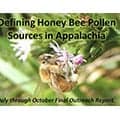In 2017, the West Virginia Beekeepers were award a SARE Grant of $15,000 to study the pollen foraging habits of bees in their part of Appalachia. The work was completed in 2018, and the WVBA wants to share its results with neighboring beekeepers!
The objective of this project was to provide for the first time, in an easy-to-understand format, a set of fact-based charts describing the relative abundance of each plant type in its contribution of pollen to honey bees during the summer and fall months (July-October) in Appalachia as bees and beekeepers prepare for winter. The study used pollen trapped at hive entrances according to a standardized protocol, pollen treatment with acetolysis, and microscopic examination of a minimum of 200 random pollen grains per sample to answer the following questions:
- What pollen types are the bees collecting?
- What is the percentage of each type at each time period?
- When are the bees bringing in the highest and lowest quantities?
- How much does it change from one location to the next?
- How much does it change from one year to the next?
- Which wild plants are most valuable to honey bee nutrition and health?
- What gaps in natural honey bee forage need to be filled?
- Are there preferable bloom periods for harvesting pollen for marketing or for supplemental honey bee feed without jeopardizing colony health?
Interesting results included the fact that the samples overall contained very little pollen from commercial crop plants. No Soy pollen was found in any of the samples, and corn was found to a meaningful degree in only one sample. Winged Sumac was found to have very high potential for a bee forage plant. Although it was not found in all locations, it accounted for more pollen intake than any other plant, sometimes by over 300%, and was a consistent bloomer from year to year. Clover and Wingstem pollen were important pollen sources almost universally. Ragweed pollen was collected to a surprisingly high degree, approaching clover in quantity. Probably the most universally important pollen type across locations was the Goldenrod type. On average, the August samples contained the highest plant diversity.
You can read the final report here!
